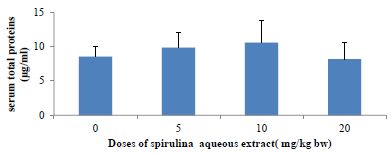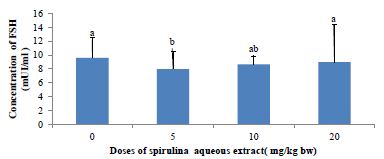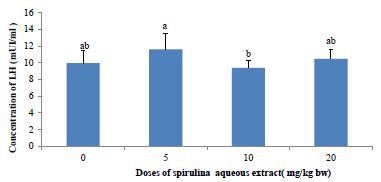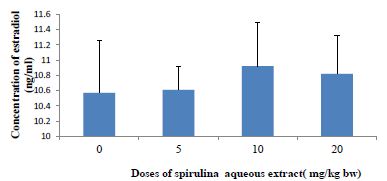Abstract
The present study was conducted to assess the effects of Spirulina platensis extract on some reproductive performances. Twenty-four nulliparous sexually mature female rabbits weighing between 2100 g and 2200 g were used. These rabbits were divided into 4 groups of 6 animals each. Each group was randomly attributed orally the following Spirulina extract doses: 0 (control group), 5, 10 and 20 mg respectively of Spirulina per kg body weight (bw) for 60 days. After 30 days of treatment, blood was collected (for analyses) and the females were mated. The treatment continued during pregnancy. Then, receptivity, fertility, weight, viability, litter size, and pups sex-ratio were determined. Spirulina extract had no significant P>0.05) effect on the rate of receptivity, fertility, viability, body weight, serum concentration of FSH, estradiol and protein. However, administration of 10 mg per kg bw produced the best results. The serum LH concentration, litter size, time limit of male acceptance, pups weight and Sex-ratio were significantly higher (P<0.05) in the group of does which received 10mg/kg of Spirulina extract. Aqueous extract of Spirulina platensis can be used to improve female reproductive performances
Keywords
Aqueous extract, Spirulina, Does, Reproduction
Introduction
For the past decades, some plants have been playing important role in disease curing along with artificial medications commonly called medicinal plants. The growing demand for natural or Bio products reanimates the rate of interest of researchers to study plants and their extracts [1]. A larger number of these plants and their extracts have shown beneficial therapeutic effects including fertility enhancing and contraceptive compounds, anti-oxidant, anti-inflammatory, anti-cancer, anti-microbial, hépatoprotective, immunological and aphrodisiac [2,3]. These properties are used in animal production [4]. Spirulina (Spirulina platensis) is a microalgae belonging to the phylum cyanophyceae and growing in alkaline, salty and warm water. Studies of Spirulina and their extract have shown they contain anti-inflammatory, anti-cancer, anti-microbial, hepato-protective and antioxidant activities [5-7]. Many studies have been conducted in animal production on the effects of aqueous extract on growth performance; but very little information exist regarding their effect on reproductive performances especially concerning spirulina aqueous extract [8,9]. Experimental studies have shown that in rats treated with Spirulina platensis at the doses 2 and 8 mg/Kg per body weight, there was an increase in the body weight, libido and rate of reproductive hormones [8-10]. Although these studies showed some positive effects of spirulina, results on the effects of its aqueous extract on the reproductive performances especially in females are rare. Thus this study was carried out to investigate the effect of the aqueous extract of spirulina on some reproductive performances in female rabbit.
Materials and Methods
Obtainment and Preparation of Spirulina platensis Aqueous Extract
The harvested spirulina were dried in the shade and then ground into fine powder. In the Laboratory of Animal Physiology of the Faculty of Agronomy and Agricultural Sciences, 250 grams of the powder were dissolved in 1.5 liters of distilled water for 48h at room temperature and filtered through Whatman number 3 paper. The filtrate obtained was transferred to an evaporator (drying-cupboard) at 45°C until a solid blackish paste was obtained. The powder was used for extraction respecting the protocol described by Bougandan [11]. The extraction yield (Y) was 26.25% determined by the following formula:
Y (%)=weight after extraction/weight before extraction x 100
Photochemistry of Spirulina platensis Aqueous Extract
Chemical screening of the AESP has been done following standard methods (Harbone, 1973) and the components revealed are presented in Table 1.
Table 1: Chemical components of aqueous extract of Spirulina platensis
|
Components |
Types of réactions |
Aqueous extract of Spirulina platensis |
| Alkaloïds | MAYER |
+ |
| Steroïds |
Liberman Buchar |
++ |
| Triterpèns |
+ |
|
| FlavonoÏds | Schinoda |
+ |
| Phénols | Chlorure ferrique/MeoH |
+ |
| Tanins | H2O/Chlorure ferrique |
++ |
| Saponins |
++ |
Solutions of the aqueous Spirulina platensis Aqueous Extract were prepared at different experimental doses by dissolution in distilled water, as indicated in Table 2.
Table 2: Preparation of the aqueous extract of Spirulina platensis Extract leaves
|
Dose (mg/kg bw) |
Quantity of extract (mg) |
VDW (ml) |
FVS (bw ml/kg) |
CS (mg/bw ml/kg) |
|
0 |
0 |
1000 |
1000 |
0 |
|
5 |
5 |
955 |
1000 |
5 |
|
10 |
10 |
950 |
1000 |
10 |
|
20 |
20 |
980 |
1000 |
20 |
| CS: Concentration of the Solution; VDW: Volume of Distilled Water; FVS: Volume of the Final Solution. | ||||
Twenty-four nulliparous sexually mature female rabbits weighing 2100-2200 g and aged 6 months, mated with untreated sexually mature male during the treatments, in the sex ratio 1:3 were used. The animals were randomly divided into 4 groups of 6 rabbits does each comparable. In terms of body weight (bw). Each group was randomly administered orally for 60 days (30 days before gestation and 30 days of gestation), the following Spirulina extract doses: 0 (control group), 5, 10 and 20 mg of Spirulina per kg body weight, done daily between 6:30 and 8:30 am. Throughout the experimental period, feed and water were provided ad libitum to animals.
After 30 days of treatment, animals were anaesthetized using blood samples were collected into tubes free of anti-coagulant for dosing biochemistry characterisics. Serum was isolated and stored at -20°C prior to analysis. Samples were centrifuged at 3000 r/min for 10 min to obtain plasma. The females were mated and reproductive performances collected.
Receptivity and Fertility
The rate of receptivity was determined using the following formula:
Rate of receptivity=(number of female which accepted male/number of female presented to male) x 100
The time limit of male acceptance was evaluated by considering the number of days taken by females to accept the male.
The rate of fertility was determined using the following formula:
Rate of fertility=(number of mated female/Total number of females) ×100
Pups Body Weight, Viability and Sex-ratio
The body weight of pups was evaluated at birth and every week during three weeks. Viability and sex-ratio were determined using following formula:
Rate of viability=(Number of life pups/total-pups) x 100
Sex-ratio of pups=(Number of male pups/Number of female pups)
Biochemical Analysis
Total protein contents in serum were determined using the methods of biuret [12]. FSH, LH and estradiol were determined using a commercial kit ELISA Pathozyme® (Omega Diagnostics Inc).
Statistical Analysis
The data collected were submitted to one way analysis of variance (ANOVA) to test the effects of different treatments of aqueous extracts (0, 5, 10 and 20 mg/kg bw) on studied characteristics. The Duncan test was performed to separate means when a significant difference existed (Vilain, 1999). The limit of significance was fixed at 5% and the software SPSS 20.0 was used for the analysis. Results were expressed as mean standard deviation.
Results
Body Weight
As shown in the Table 3, Spirulina aqueous extract had no significant effect (P>0.05) on the body weight of the animals. However, body weight increased more with the dose of 10 mg/kg bw of extract than the other groups.
Table 3: Centesimal composition and bromatological characteristics of the ration
|
Ingredients |
Amount (kg/100 kg) |
| Corn |
25.00 |
| Bran wheat |
10.00 |
| Palm kernel cake |
15.5 |
| Cotton seal meal |
5.00 |
| Soybean meal |
10.00 |
| Fishmeal |
4.00 |
| bone meal |
1.00 |
| Premix 5% |
5 |
| Salt |
0.5 |
| Palm oil |
4.00 |
| Pennisetum purpurum |
20.00 |
| Total |
100.00 |
| Chemical Characteristics | |
| Metabolized energy (Kcal/kg) |
2600.00 |
| Crude protein (%) |
19.00 |
| Crude fiber (%) |
14.18 |
| Calcuim (%) |
1.05 |
| Phosphorus (%) |
0.68 |
| Sodium (%) |
0.27 |
| Lysin (%) |
1.01 |
| Methionin (%) |
0.4 |
Receptivity, Fertility, Pups Body Weight, Viability and Sex-ratio
Administration of spirulina aqueous extract to females significantly increased (P<0.05) the litter size, pups body weight and sex-ratio dose-dependently compared to control group. The time of male acceptance decreased significantly with the dose of 10mg/kg body weight of aqueous extract of spirulina. Except for the dose 20 mg/kg bw, the rate of receptivity was 100% whatever the group (Table 5).
Table 4: Effects of aqueous extract of Spirulina on the body weight of female does
|
Characteristics |
Doses of Spirulina aqueous extract (mg/kg b w) |
||||
|
0 (n= 6) |
5 (n=6) |
10 (n=6) |
20 (n=6) |
p |
|
| Initial body weight |
2120,17 ± 439,21a |
2033,83 ± 165,86a |
2094,80 ± 294,80a |
2045,14 ± 244,55a |
0.73 |
| Body weight after 30 days of treatment |
2408,33 ± 430,70 |
2240,17 ± 222.89 |
2516,00 ± 209,33 |
2352,85 ± 182,73 |
0.51 |
| Final Body weight at parturition |
2869,66 ± 410,07a |
2692,83 ± 175.89a |
2953,60 ± 184,40a |
2841,17 ± 285,03a |
0.61 |
Table 5: Effect of spirulina aqueous extract on reproductive performances of female does
|
Characteristics |
Doses of spirulina aqueous extract ( mg/kg bw) |
||||
|
0 (n=6) |
5 (n=6) |
10 (n=6) |
20 (n=6) |
p |
|
| Rte of receptivity (%) |
100 ± 0.00 |
100 ± 0.00 |
100 ± 0.00 |
95.71 ± 7.8 |
0.15 |
| Time of male acceptance |
1.71 ± 1.11ab |
2.33 ± 1.37a |
1.00 ± 0.00b |
1.83 ± 0.00ab |
0.03 |
| Fertility (%) |
100 ± 0.00 a |
66.67 ± 51.54 b |
100 ± 0.00 a |
100 ± 0.00 a |
0.01 |
| Litter size |
5.85 ± 1.14b |
6.25 ± 0.96ab |
7.8 ± 1.70a |
5.60 ± 0.89b |
0.03 |
| Pups body weight at birth (g) |
50.98 ± 7.12 |
52.8 ± 9.55 |
55.58 ± 3.48 |
55.66 ± 4.63 |
0.60 |
| Pups body weight at 3 weeks (g) |
266 ± 56.51 b |
292 ± 36.62ab |
311.5 ± 37.25 a |
290.66 ± 48.013ab |
0.05 |
| Pups viability at birth (%) |
90.00 ± 22.36 ab |
100 ± 0.00 a |
67.5 ± 46.43 b |
97.55 ± 5.49 a |
0.01 |
| Pups viability at 3 weeks (%) |
30.47 ± 24.57 |
37.77 ± 42.71 |
40 ± 41.82 |
33.71 ± 35.82 |
0.73 |
| Sex-ratio |
0.50 ± 0.70b |
1.53 ± 0.58ab |
2.33 ± 1.53a |
1.33 ± 0.58ab |
0.00 |
Biochemical Characteristics
It appears that the serum LH increased significantly (P>0.05) with spirulina extract dose compared to the control group. The value obtained from the group that received 10mg/kg bw was higher than that of the other groups. The administration of spirulina aqueous extract did not significantly affect the serum FSH and estradiol. However the latter increased dose-dependently with higher values for the group of rabbits which received 10 mg/kg b w of extract (Figures 1-4).

Figure 1: Effects of spirulina aqueous extract on serum total proteins

Figure 2: Effects of spirulina aqueous extract on FSH concentration

Figure 3: Effects of spirulina aqueous extract on LH concentration

Figure 4: Effects of spirulina aqueous extract on estradiol concentration
Discussion
The results of this study indicated that Spirulina platensis had a significant increase on the litter size and pups body weight. These results are comparable to those found by Lienou et al. [13] in female rats treated with aqueous extract of Senecio biafrae at the dose of 32 and 64 mg/kg bw and Ainehchi and Zahedi, [14] in female rats treated with 200 and 400 mg/kg bw of hydroalcoolic extract of Artemisia lanata. This may be due to the induction of follicular growth or folliculogenesis. In fact, the process of follicular growth is under the control of FSH and LH. This extract may have biological compounds or analogous of a general excitatory neurotransmitter of the central nervous system which induce the pulsatile releases of GnRH. The latter leads to the pulsatile release of pituitary hormones which enhance the proliferation of the follicles and therefore increase litter size. The increase of pups body weight can be attributed to essential amino acids [15] present in the spirulina. This work also revealed a significant increase of pups sex-ratio in treated groups. This result could be explained by the synthesis and the action of androgens secretes by fetal testicle during sexual differentiation. In fact, spirulina antioxidant activity and its antioxydant power may protect against disturbing androgens. These disturbing androgens cause gonads feminization.
The aqueous extract of Spirulina platensis also resulted in a significant decrease of the time of male acceptance. These results corroborated the finding of Lienou et al. [13] in female rats treated with aqueous extract of Senecio biafrae at the dose of 8 and 32 mg/kg. Estrogens and estrogen –like (phytoestrogens) are well known regulators of receptivity in rabbits [16]. They exert their biological effect following their fixation to the receptors in their main target organs (ovary, uterus, hypothalamus…) thus leading to a chain of reactions, culmulating in the biosynthesis of biomacromolecules and the increase of sexual appetite. As concerning the test on biochemical parameters, a non-significant increase in serum protein in rabbits which received extract of spirulina was obtained. These results are comparable to those found by Kameni, [17]. In rats treated with aqueous extract of Nymphaea lotus at the dose of 75 mg/kg bw, and Kamtchouing et al. [18] in rats treated for 8 days with Pentadiplandra brazzeana. This may be due to the high digestibility of protein contained in the spirulina. The Spirulina platensis aqueous extract treatment also resulted in a significant increase of LH. These results corroborated the finding of Adaay et Mattar [19] in female rats treated with a mixture of aqueous and ethanolic extract of Tribulus terrestris, Phoenix dactylifera and Nasturtium officinale at the doses of 75, 150 and 300mg/kg/days et contradict the finding by Woode et al. [20] in male rats treated with éthanolic extract of Xylopia aethiopica fruits at the doses of 30, 100 et 300 mg/kg bw. This elevation may explain the increase in the litter size mentioned before and the increase of estradiol also. It is known that LH induces the pulsatile release of estrogen by stimulating ovary.
Conclusion
From the study on the effects of aqueous extracts of Spirulina platensis on the reproductive characteristics of rabbit does, the main conclusions were as follows: the Spirulina platensis aqueous extract had beneficial effects on reproduction by stimulating the production of LH estradiol and serum protein concentration and improves the litter size, time limit of male acceptance, pups weight and Sex-ratio. The reproductive characteristics were put to evidence by the significantly greater concentrations of LH with the maintenance of fertility. Therefore it can be advised for use by female to improve the reproductive performance. In case of its utilization, the dose 10 mg/kg bw is recommended, since protective effects were more pronounced at this dose.
Conflict of Interest Statement
We declare that we have no conflict of interest.
Funding
This research received no external funding.
Author Contributions
Conceptualization was done by DEUTCHEU NIENGA Sorelle, VEMO Bertin Narcisse and Ngoula Ferdinand.; Methodology, data collection and writing was done by DEUTCHEU NIENGA Sorelle, VEMO Bertin Narcisse and CHONGSI Margaret Mary Momo.
Data Availability
The data sets used during the current study are available from the corresponding author upon reasonable request.
References
- Agence Française de Sécurité Sanitaire des Aliments (AFSSA) (2007) Propositions pour une démarche d’évaluation de substances ou de produits « nouveaux » destinés à l’alimentation animale Cas particulier des substances et produits à base de plantes.
- Kale BP, Kothekar MA, Tayade HP, Jaju JB, Mateeddin M (2003) Effect of aqueous extract of azadirachta indica leaves on hepatotoxicity induced by antitubercular drugs in rats. Indian Journal of Pharmacology 35.
- Chowdhury NY, Islam W, Khalequzzaman M (2009) Insecticidal Activities of Stem Bark Extracts from Vitex negundo L. against Tribolium castaneum (Herbst). Journal of Bio-sciences 17: 63-70.
- Recoquillay F (2009) L’intérêt des huiles essentielles. 9ème Journée Productions porcines et avicoles.
- Wu LC, Ho JA, Shieh MC, Lu IW (2005) Antioxidant and antiproliferative activities of Spirulina and Chlorella water extracts. Journal of Agriculture Food and Chemistry 53: 4207-42012. [crossref]
- Guan XY, Zhang WJ, Zhang XW, Li YX, Wang JF, et al. (2009). A potent anti-oxidant property: fluorescent recombinant alpha -phycocyanin of Spirulina. Journal of Applied Microbiology: 1093-10.
- Banks J., (2007) Etudie de la faisabilité de la mise en place d’une filière spiruline sur le site du Palacret, dans les Côtes d’Armor (22). pp 6.
- James R, Sampath K, Thangarathinam R, Vasudevan I (2006) Effect of dietary spirulina level on growth, fertility, coloration and leucocyte count in red swordtail, Xiphophorus helleri. Israeli Journal Of Aquaculture Bamidgeh 58: 97-104.
- Kim CJ, Yoon SK, Kim HI, Park YH, Oh HM (2006) Effect of Spirulina platensis and probiotics as feed additives on growth of shrimp Fenneropenaeus chinensis. Journal of Microbiology and Biotechnology 16: 1248-1254.
- Razafindrajaona JM, Rakotozandriny J, Randria Ramampiherika (2010) Etude de la performance nutritionnelle de la spiruline de Madagascar (Spirulina platensis variété Toliarensis) sur la souris.
- Bougandoura N (2010) Pouvoir antioxydant et antimicrobien des extraits d’espèces végétales Sature jacalaminthas spnepta (nabta) et Ajugaiva L. (chendgoura) de l’ouest d’Algérie. Mémoire magister; université Tlemcen.
- Gornal AG, Bardwil GS, David MM (1949) Determination of serum proteins by mean of Biuret reactions. Biochemistry 177: 751-766. [crossref]
- Lienou LL, Telefo BP, Bale B, Yemele D, Tagne RS, et al. (2012) Effect of the aqueoux extract of Senecio biafraeon sexual maturation of immature,femelle rat.
- Ainehchi N, Zahedi A. (2014) Effects of Artemisia lanata extract on Reproductive parameters of female rats. Crescent Journal of Medical & Biological Science 1: 49-53.
- Garreau H, Rochambeau H de (2003) La sélection des qualités maternelles pour la croissance du lapereau. 10èmes Journées de la Recherche Cunicole, INRA-ITAVI, 19-20 nov. 2003, Paris, ITAVI, Ed. Paris, 61-64.
- Salissard Marie (2013) La lapine, une espèce à ovulation provoquée.Mécanismes et dysfonctionnement associé: la pseudo-gestation.Thèse d’exercice, Médecine vétérinaire, Ecole NationaleVétérinaire de Toulouse – ENVT, 2013, 102 p.
- Kameni PM (2011) Evaluation des effets de l’extrait aqueux des fleurs de Nymphaea lotus L. (Nymphéacées) sur la fonction de reproduction des rats normoglycémique et diabétique de type 1. Thèse de Masters, Université de Yaoundé 1. pp. 36-70.
- Kamtchouing P, Fandio GYM, Dimo T, Jatsa HB (2002b) Evaluation of androgenic activity of Zingiber officinale and Pentadiplandra brazzeana in male rats. Asian Journal of Andrology. 4: 299-301.
- Adaay MH, Mosa AAR (2012) Evaluation of the effect of extract of Tribulus terrestris on reproductive parameters in female mice. J Mater Environ Sci 3: 1153-1162.
- Woode E, Alhassan A, Chrissie SA (2011) Effect of ethanolic fruit extract of Xylopia aethiopica on reproductive function of male rats. International Journal of Pharmaceutical and Biomedical Research 2: 161-165.